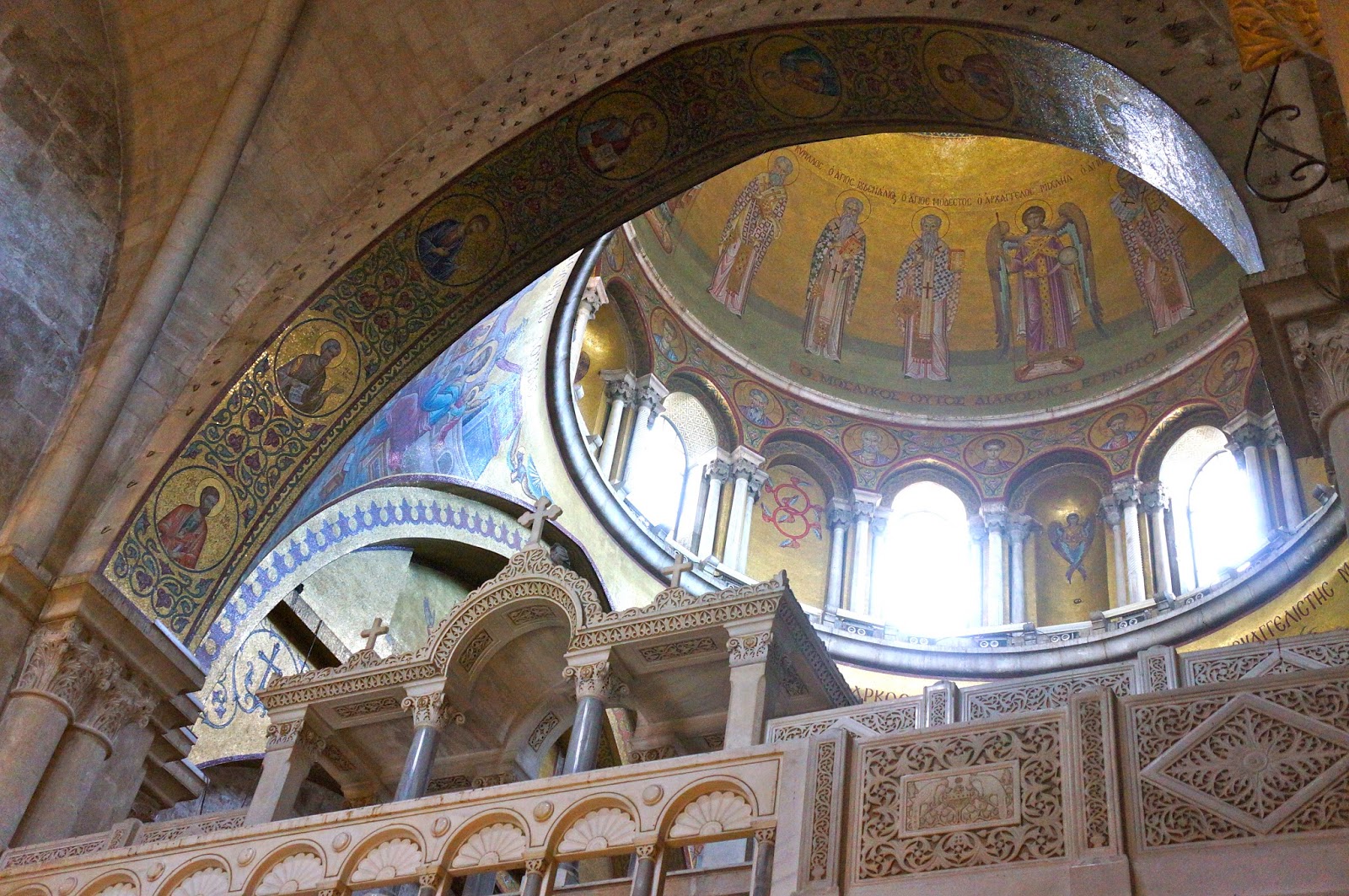The Via Dolorosa, the road Jesus walked from the place of Pontius Pilate’s sentencing to Golgotha, means “way of sorrows.”
 |
| The Stations are located along many traders like this so it is difficult to have personal quiet reflection time. |
Via Dolorosa is located within the old city of Jerusalem. It starts from the place where he was tried and convicted - near the Lion's Gate on the eastern side (Muslim quarter). It ends in the crucifixion place, Golgotha, where the Church of the Holy Sepulchre is located in the west side of the old city (Christian quarter).
There are 14 Stations of the Cross along the Via Dolorosa and each is marked with a plaque on the wall.
Station 1: Jesus is condemned to death
Mark 15:1
Jesus was tried and condemned by Pontius Pilate in the Praetorium, the Antonia Fortress, the Antonia Fortress, headquarters of the Roman garrison stationed in Jerusalem and residence of the procurator when he visited Jerusalem.
Jesus was tried and condemned by Pontius Pilate in the Praetorium, the Antonia Fortress, the Antonia Fortress, headquarters of the Roman garrison stationed in Jerusalem and residence of the procurator when he visited Jerusalem.
Today, the 1st Station is in the courtyard of the Al-Omariya school or Madrasa al-Omarira, 300m west of the Lion's Gate
Station 2: Jesus receives His Cross




John 19:2-3
The Franciscan Chapel of the Flagellation and the Chapel of Condemnation commemorate the sites where Jesus was scourged and given the Cross to bear.

Every Friday, there is a Mass whereby Christians can
join in a service to carry the Cross and walk from here
to the last Station.
 |
 |
Station 3: Jesus falls the first time under His Cross
An Armenian Catholic chapel marks the spot where Jesus fell for the first time and above the entrance of this chapel, there is a relief of Jesus falling under the eight of the Cross. (This event is not recorded in the Bible)
Station 4: Jesus meets Mary His Mother
This is where Mary watched her son go by with the cross, and is commemorated at the Armenian Church of Our Lady of the Spasm. (This event is not recorded in the Bible.)
Station 5: Simon helps Jesus to carry His Cross
This is where Simon of Cyrene was forced by Roman soldiers to help Jesus carry this cross (Mt 27:32; Mk 15:21; Lk 23:26). This is located on the corner where the Via Dolorosa turns west off al-Wad Road and begins to narrow as it goes uphill.
 |
| This is a hand print on the wall which is believed to be the hand print of Jesus when He leaned to rest. |
Station 6: Veronica wipes the face of Jesus
Here according to a tradition dating from the 14th century, St. Veronica wiped Jesus' face with her handkerchief, leaving an image of his face imprinted on the cloth. The relic, known as the Sudarium orVeronica, is kept at St. Peter's Basilica in Rome. Veronica's name may derive from the Latin vera icon, "true image." This Church here now belongs to the Little Sisters of Jesus. (This event is not recorded in the Bible)


Station 7: Jesus falls the second time
Here Jesus fell for a second time. This is marked by a Franciscan chapel at the Via Dolorosa's junction with Souq Khan al-Zeit. (This event is not recorded in the Bible)
Station 8: Jesus speaks to the women of Jerusalem
Here Jesus was to have consoled the lamenting women of Jerusalem
Station 9: Jesus falls the third time
Here, a Roman pillar marks the site of Jesus' third fall. This pillar was built into the door of the Coptic Church next to the Church of the Holy Sepulchre.
 |
| The Pillar that marks the place that Jesus fell is at the far end of this lane. |
Situated just next to Station 9 is the Ethiopian Church. Listen to the video to learn some interesting facts about the Ethiopian people and their Church.
 |
| The above 3 photos are of the Ethiopian compound |
 |
| The low entrance door to the Ethiopian Church |
 |
| Inside the Ethiopian Church |
Stations 10-14 are all inside the Church of the Holy Sepulchre. The 2 videos below are the explanation of our tour guide preparing us of what to expect and see inside the Holy Sepulchre.
Station 10: Jesus is stripped of His garments
Station 11: Jesus is nailed to the cross
Here Jesus was nailed to the Cross, believed to be upstairs just inside the entrance, at the Latin Calvary.
Stations 12: Jesus dies on the cross
Station 13: Jesus is taken down from the cross
Here Jesus was taken down from the cross. This place is marked by the Statue of Our Lady of Sorrows next to the Latin Calvary.
The Stone of Anointing - An altar marks the spot where Mary received the body of Jesus after He had been taken down from the Cross. Jesus' body was then laid out on the Stone of Anointing (Unction) and anointed with a mixture of myrrh, aloe and aromatic oils in preparation for burial.
The Stone of Anointing - An altar marks the spot where Mary received the body of Jesus after He had been taken down from the Cross. Jesus' body was then laid out on the Stone of Anointing (Unction) and anointed with a mixture of myrrh, aloe and aromatic oils in preparation for burial.
Station 14: Jesus is laid in the tomb
Station 14: Jesus was laid in the tomb marked by the edicule on the main floor.







































No comments:
Post a Comment